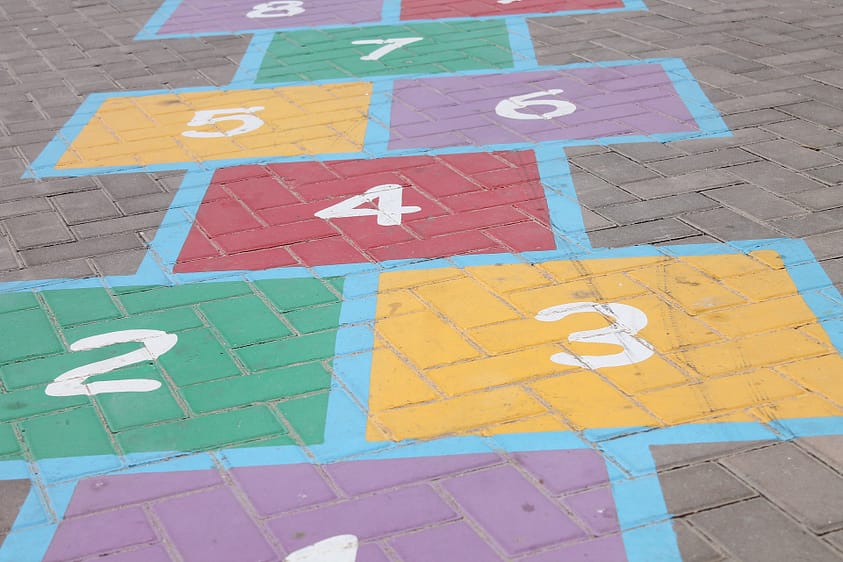COVID has changed many things. Kids are now on computers for several hours a day. Parents often need to supervise them during this season of online school. What can parents do to keep their kids busy and physically active?
This is Part-II of my Kid Fitness Lock down Edition. In Kid Fitness Lock down Edition-Part I, I discussed the benefits of exercise for children and adolescents, as well as the recommendations based on their ages. Here is another chart from health.gov.

In 2012, Nike launched a ‘Designed to Move’ Program. Below is a graphic from it of the compounding benefits of physical activity over a lifetime:

Now for the compounding costs of physical inactivity over a lifetime:

The Physical Activity Guidelines for Americans, 2nd edition, 2019, has presented the following table:
| Type of Physical Activity | Pre-School Aged Children | School-Aged Children | Adolescents |
| Moderate-Intensity Aerobic | •Games such as tag or follow the leader •Playing on a playground •Tricycle or bicycle riding •Walking, running, skipping, jumping, dancing •Swimming •Playing games that require catching, throwing, and kicking •Gymnastics or tumbling | •Brisk walking •Bicycle riding •Active recreation, such as hiking, riding a scooter without a motor, swimming •Playing games that require catching and throwing, such as baseball and softball | •Brisk walking •Bicycle riding •Active recreation, such as kayaking, hiking, swimming •Playing games that require catching and throwing, such as baseball and softball •House and yard work, such as sweeping or pushing a lawn mower •Some video games that include continuous movement |
| Vigorous-intensity Aerobic | •Games such as tag or follow the leader •Playing on a playground •Tricycle or bicycle riding •Walking, running, skipping, jumping, dancing •Swimming •Playing games that require catching, throwing, and kicking •Gymnastics or tumbling | •Running •Bicycle riding •Active games involving running and chasing, such as tag or flag football •Jumping rope •Cross-country skiing •Sports such as soccer, basketball, swimming, tennis •Martial arts •Vigorous dancing | •Running •Bicycle riding •Active games involving running and chasing, such as flag football •Jumping rope •Cross-country skiing •Sports such as soccer, basketball, swimming, tennis •Martial arts •Vigorous dancing |
| Muscle Strengthening | •Games such as tug of war •Climbing on playground equipment •Gymnastics | •Games such as tug of war •Resistance exercises using body weight or resistance bands •Rope or tree climbing •Climbing on playground equipment •Some forms of yoga | •Games such as tug of war •Resistance exercises using body weight, resistance bands, weight machines, hand-held weights •Some forms of yoga |
| Bone Strengthening | •Hopping, skipping, jumping •Jumping rope •Running •Gymnastics | •Hopping, skipping, jumping •Jumping rope •Running •Sports that involve jumping or rapid change in direction | •Jumping rope •Running •Sports that involve jumping or rapid change in direction |
We can see that the intensity of the same exercise can make it either moderate or vigorous intensity. For example, riding the bicycle at a moderate pace would count as moderate intensity, but racing it would amount to vigorous intensity. It depends on the level of effort involved.
Special Considerations for children and adolescents with disabilities
- Children and adolescents with disabilities are more likely to not get the recommended amounts of exercise.
- Physical activity specialists or healthcare professionals should help them with the appropriate amounts and types of physical activities according to their special situations.
- Ideally, youth with disabilities should be as active as is possible for their ability.
In summary, suggested games/activities for children and adolescents include:
Children

- Hide-n-seek
- Hopscotch
- Playing in the backyard on slides or other equipment if there is any available
- Playing games inside the house, especially when the weather is not suited for outside play.
- Riding tricycle or bicycle
- Walking in the neighborhood with the family
- Running
- Skipping
- Blowing bubbles and chasing them
- Squats
- Bear crawl
- Crab walk
Adolescents


- Mowing the yard
- Vacuuming the house
- Raking leaves
- Cleaning different areas of the house
- Bicycling
- Walking the dog
- Shooting hoops
- Doing planks and pushups
- Playing frisbee
- Body-weight exercises
- Active video games
This is no doubt a challenging time. You might think, that’s too much or I can barely help the kids with the academics. But just remember, the benefits of exercise for your kids include not just improved moods and higher grades, but better health and life for the future as well. By encouraging exercise/activity, you’ll be helping your kids in more ways than one.
Remember to make exercise fun—make it a positive experience for your kids. You are helping them start healthy habits, which they should continue for the rest of their lives.
Designed to Move has a great link with fun activities for kids.
Go check out Kids’ Fitness Lock down Edition-Part I, and let me know if these posts are beneficial. Then check out some Exercise Recommendations for yourself. Comment below.
Sources:
Physical Activity Guidelines 2nd edition
cdc.gov
health.gov
activeforlife.com
Designed to move report
I linked this post at:


“Journey to Health with Priya” provides general educational information on various topics on this website as a public service, which should not be construed as professional medical advice.



Great ideas #anythinggoes@_karendennis
I saw your link on the Wonderful Wednesdays link up. This is such an important topic. You have included a lot of helpful information and simple ideas that any family could do. Thank you for sharing!
Thanks Marielle. I’m glad it was of use. Please share with others who have kids at home.